This is in fact only the end of a study whose too dense foreground could have misled the pupils (if some had undertaken to seek the solution).
1:d8=Q Qxc6! (not very difficult to find) and there we see that the material is insufficient to win (for example after Qxg5) and the position would be null if B did not have the disadvantage of having the Q in the grip. The charming and forced continuation can (and should!) be searched for head on from here.
2:Qa5 Bd2 3:Qa1 Qc1 4:Nd3 (of course, you must not stop there!) Kd1 5:Qa4! (5:Nxc1 Bc3+! would lead to a model stalemate) Qc2 6:Qg4# the model stalemate being avoided and replaced by a model mate.
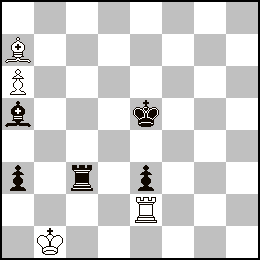 Exercise 3 ? (To tell the truth, I don't remember if it was a previously given exercise or if it was one of the studies given as usual before today's game). W(4): Kb1 Ba7 Re2 Pa6. B(5): Ke5, Rc3, Ba5, Pa3,e3. W to play and win.
Exercise 3 ? (To tell the truth, I don't remember if it was a previously given exercise or if it was one of the studies given as usual before today's game). W(4): Kb1 Ba7 Re2 Pa6. B(5): Ke5, Rc3, Ba5, Pa3,e3. W to play and win.
This study is much more difficult, especially because of potential false leads. It is therefore quite easy to find when guided, but less so when alone. Try 1:Rxe3? Kd5! 2:Bb8 Rxe3 3:a7 Kc4! and the draw is now clear.
1:Bb8+ Bc7 What to do when you see that on 2:a7? Rb3+! leads to a draw ?
2:Rxe3 Rxe3 3:Bxc7 Kd4 again a false lead : 4:Bb6? Kd5! 5:Be3 Kc6 6:Ka2 Kc7 7:Ba7 Kc6 and draw, wK being a square too far from b5.
4:a7 a2+ 5:Ka2 Re2 6:Kb3 Re3 7:Kb4 Re8! (7:..Re1 8:Bb6+ !) 8:Bb8 Re1 9:Be5+ and win.
Then there are some serious errors of analysis of very strong players that the Master found during his complete re-reading of the first 100 informants and which are obviously of educational interest to the audience.
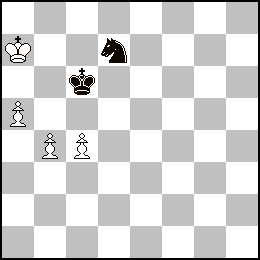 W:Ka7 Pa5,b4,c5. B:Kc6, Nd7. Black to move. Draw.
W:Ka7 Pa5,b4,c5. B:Kc6, Nd7. Black to move. Draw.
What you should know in this type of position: the pawns can generally be stopped if they have not yet all reached the 5th row. Here, one is still far from it, it is thus necessary as soon as possible to force the pawns to be fixed to define the holes in which the N can organize itself. Moreover, it is quite obvious that the RN would be ill advised to come to c7 where he will allow the Bs to advance with gain of time on check whereas it is precisely when the P's advance that the B's must have the necessary freedom to organize themselves.
1:Ne5 ! b5 2:Kc5! (on 2:c5, find the very clear B move that ends the question immediately) b6 3:Nc4 (To get used to these positions, note that 3:Kxc4 is also possible because on 3:..b7 W's again have a very clear move that immediately draws) 3:..b7 4:Na5! and draw.
This is followed by an analysis error by Morozevich where he forgets the win when the Bs play the right move and misses the draw when the Bs play the wrong move. But being only the substitute clerk, I didn't have the capacity to follow the analysis and note the details at the same time. So I let the pencil cool down.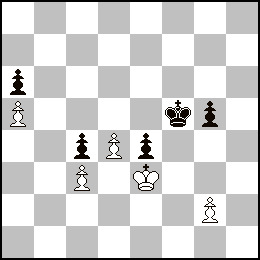
Here are the 3 exercises for next session :
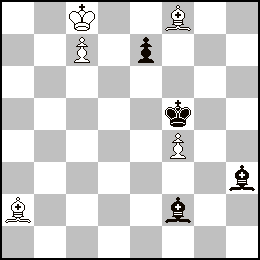 White to play and draw
White to play and draw
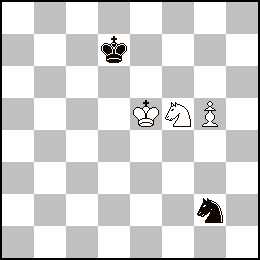
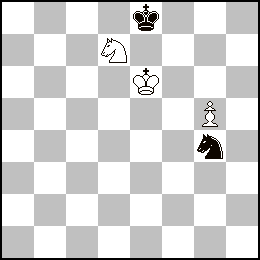 In both cases, the Bs play and draw, both positions having been wrongly given as losing.
In both cases, the Bs play and draw, both positions having been wrongly given as losing.
Game of the day.
For a change, Master presented us with a game played between two women. We don't know exactly why he made this choice. A week dedicated to women? Stefanova's physique? The tactical richness of the game? Yes, certainly the latter.
Vasilevich - Stefanova (And a world champion's doll)
1.d4 d5 2.c4 c6 3.Nf3 Nf6 4.Nc3 a6 5.Ne5 dxc4 6.Nxc4 b5 7.Ne5 Bb7 8.Bf4 e6 9.e3 Nbd7 [9...c5! 10.dxc5 Qxd1+ 11.Rxd1 Bxc5 12.Be2 Nbd7 levels] 10.Be2 c5 11.0–0 cxd4 12.exd4 Nb6?! The Bs think that the locking of d5 makes them safe from everything, which seems to be true, and yet this position is to W's advantage, allowed by the Bs' developmental delay ... which one must be able to underline !
13.a4! Nfd5 [a4! is allowed here, as 13...b4 14.a5! bxc3 (14...Nbd7 15.Qb3 Be7 16.Nd3) 15.axb6 cxb2 16.Qa4+! and we have time to play Rb1–Rb2 with great advantage] 14.Nxd5
Here came the surprise of the evening, opened by a loud shout from the back of the room. For those of you who are used to it, the great cry coming from the back is a classic one produced by our friends who practice Qi Gong (and who precisely forbid anyone ("quiconque" in french) to concentrate during the crying phase) but here, the roar was even more powerful and could obviously only have been emitted by the Great Stone (which I could also have called Pier the Great, but I think that's already been used). A new reinforcement had therefore just arrived, which obviously led to an increase in the number of resources on offer, but which did not make note-taking any easier.
Especially since Pierre, hardened by the terrible public utility work done in the Bundesliga, was completely unleashed for once when he finally saw flesh that was a little more tender, i.e. at less than 2550 Elo.
[14.Bg3 Pierre proposed not to exchange on d5, according to the principle that if the B's have several pieces fighting for access to a square, exchanges on this square can only relieve their position. So the following was examined : 14...Nxc3 15.bxc3 bxa4 whereupon the Ws had a very active position but in which the Master showed with the Bs an ability to defend the bins which impressed the assembly greatly. This phase was too dense for the writer's copying skills !(15...Nxa4? 16.Rxa4) ]
14...Nxd5 15.Bg3 b4 16.a5 Bd6 17.Qa4+ Ke7 18.Rfe1 Bxe5 19.dxe5 g5 To prevent f4, so ... 20.f4! Kf8 21.f5 exf5 22.Rad1 Qe7 23.Rd4 Kg7 24.Bf3 Rhd8 25.Red1 Ne3 26.Rxd8 Bxf3?! It was necessary here to give a piece, for an activity which, if it is real, should not be obvious to everyone during a game ! 26...Rxd8! 27.Rxd8 Qxd8 28.Bxb7 and then ? 28...f4! 29.Qxb4 (29.Bf2? Qd2! 30.Qa1 Nd1!; 29.Be1? Qd3!!) ]
27.Rxa8? [tempting was 27.R1d7?! Qc5 28.Rxf7+! Kxf7? (28...Kg6 leads to a draw, but with a big black initiative) 29.Qe8+! Kg7 30.Rd7+ Kh6 31.Qe6+ Kh5 32.Rxh7+ Kg4 33.Rh4+! gxh4 34.Qg6#; And the best was 27.Qd7! ] 27...Bxa8 28.Qd7 Qc5 29.Qd6 Qc6 30.Qxc6 Bxc6 31.Rc1 Be4 32.Rc7 Kg6 33.Bf2 Nxg2 34.Ra7 Nf4 35.Rxa6+ Kh5 36.Rb6 Nd3 37.Bd4! Kg4 38.a6 Kf3 39.a7? [39.e6! fxe6 40.Rxe6+-] 39...Ke2 40.Rb8 Ne1= 41.a8Q? It was necessary to play Bf2 41...Nf3+ 42.Kg2 Nxd4+ 43.Qxe4+ fxe4–+ 44.Rf8 Nc6?= et la partie fut nulle après des coups que je n'ai pas notés.[Il fallait jouer 44...e3! 45.Rxf7 Kd2 46.Rd7 e2 47.Rxd4+ Ke3 48.Re4+ Kxe4 49.Kf2 Kxe5 50.Kxe2 Ke4–+].
The evening continued at the dinner as usual, where the merry gathering played fairy chess during the libations. Pierre was absolutely dazzling, but I can't give the report because it's 1pm and I have to capture the train to Bergerac in just over an hour!
Have a good read.
Add a comment